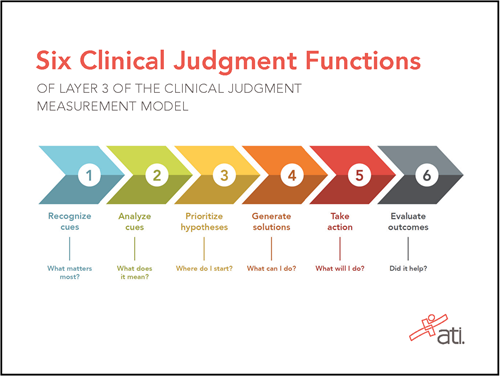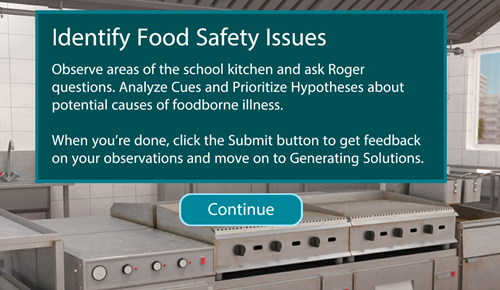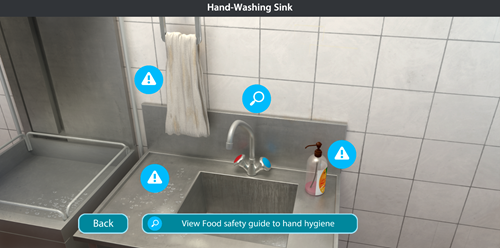Teaching nursing students how to prioritize hypotheses using interactive learning tools
Developing strong clinical judgment skills in nursing students is a primary focus for all nurse educators because it is essential for success on the NCLEX and in nursing practice. Building this skill set is a step-by-step process that focuses on one clinical judgment function at a time.
Learn how the Engage Series can help nursing students prioritize hypotheses.
The National Council of State Boards of Nursing (NCSBN) established these six functions in its Clinical Judgment Measurement Model, depicted below. Read more about this model in a previous Nurse Educator Blog post here.

This article is the third in a series that focuses on the development of clinical judgment skills and the most impactful resources to support faculty as they lay the groundwork for student acquisition of these skills. (Find the first two articles here.) This discussion focuses on teaching students how to prioritize hypotheses, the third clinical judgment skill in the NCSBN model.
What is involved in prioritizing hypotheses?
The NCSBN defines the clinical judgment skill of prioritizing hypotheses as evaluating and ranking hypotheses according to priority (urgency, likelihood, risk, difficulty, time, etc.). When prioritizing hypotheses, a nurse determines which explanations for the problem are most likely and least likely, and which possible explanations for the problem have the most serious health implications. The nurse places the potential issues in a clinical scenario in their order of likelihood (e.g., most likely to least likely).
In a recent webinar presentation, ATI Strategic Nursing Advisor Beth Cusatis Phillips, PhD, RN, CNE, CHSE, provided further explanation of this clinical judgment function. You can view this recording here.
At its core, prioritizing hypotheses requires the nurse to establish priorities based on the client’s health problem. The nurse should consider:
- the client’s signs and symptoms
- risk assessment findings
- the urgency of the presentation
- diagnostic test results, lab values, and other available objective findings
- environmental factors.
When prioritizing hypotheses, the nurse also assesses expected client responses and behaviors. Specifically, the nurse should:
- organize the client assessment information according to changes, patterns, and trends
- use standards of care and empirical frameworks to set priorities
- establish and prioritize client problems and needs based on the analysis of information and factors.
“Once students recognize and analyze cues, they need to think about how to prioritize what they have found,” Dr. Phillips said. “In order to prioritize, they must interpret the data they found and analyze it. This is such an important step in their growth.”
Teaching students to prioritize hypotheses using interactive resources
Dr. Phillips highlighted ways that nursing students can put these principles into action using the Engage Series from ATI. Engage is an interactive learning solution that helps students develop clinical judgment and practice readiness. It brings learning to life using multimedia case studies, virtual experiences, documentation in an electronic health record, and much more. Engage is designed to replace or supplement traditional textbooks by providing education, practical application, and remediation all in one place. This modern-day approach to education is described in ATI’s exclusive report, The Learning Shift.
During her webinar presentation, Dr. Phillips focused on one of the four available Engage content areas available as of fall 2023: Engage Community and Public Health. The other content areas in the Engage Series are Fundamentals, Mental Health, and Adult Medical-Surgical. Each solution in the Engage Series teaches clinical judgment skills.
Dr. Phillips showed examples of content in Engage Community and Mental Health to illustrate some of the valuable ways this resource teaches students how to prioritize hypotheses.
“When students learn to prioritize care needs, they learn about organizing information, seeking out patterns and cues that guide their decisions, and using priority-setting frameworks to determine their next action,” she said.
One of the Engage Community and Public Health modules provides a virtual simulation of a day in the life of a public health nurse. In the case depiction, a school nurse is consulted about a series of gastrointestinal symptoms that develop in a large number of elementary school students.

After a foodborne pathogen is identified as the cause, the nurse visits the school kitchen to identify a possible source and to develop prevention strategies.
“With Engage, students get practice recognizing and analyzing the cues they find in order to prevent further spread of illness,” Dr. Phillips explained. “Then, the product prompts them to prioritize what to do next.”
In this learning module, students see the public health nurse visit the school kitchen and examine all areas where food is handled. They see the nurse examine surfaces, equipment, and supplies.

“Hopefully, they recognize that old-fashioned cloth towel hanging in the left area of the sink. If they do, they will realize that this is a breeding ground for bacteria and viruses, and the kitchen workers’ hands never get clean,” Dr. Phillips said. “This should be a priority to correct.”
Address clinical judgment functions with a single resource
Although this article — and the linked webinar recording — focus on the clinical judgment function of prioritizing hypotheses, the school kitchen scenario in Engage Community and Public Health takes the student through the remaining three functions as well: generate solutions, take actions, and evaluate outcomes.
The scenarios presented throughout the Engage Series build upon each other to develop all six clinical judgment functions. All lessons are mapped to 46 key nursing concepts for easy integration into a concept-based curriculum or a traditional curriculum. Find the complete list of mapped curriculum concepts here.
“Engage provides a safe environment where students can learn critical lessons without an actual client experiencing a poor outcome,” Dr. Phillips said. “They can also repeat lessons and learn where their thinking may have been off the first time around. Building this knowledge and giving students practice will not only help them be successful on the national licensure exam, it also will make them stronger nurses in practice.”
Click the image below to learn about all four offerings in the Engage Series.
Learn more about the Engage series
